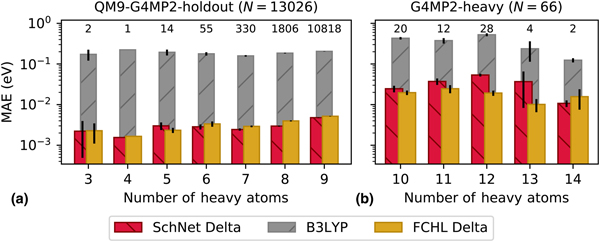Crossref Citations
This article has been cited by the following publications. This list is generated based on data provided by
Crossref.
Blaiszik, Ben
Ward, Logan
Schwarting, Marcus
Gaff, Jonathon
Chard, Ryan
Pike, Daniel
Chard, Kyle
and
Foster, Ian
2019.
A data ecosystem to support machine learning in materials science.
MRS Communications,
Vol. 9,
Issue. 4,
p.
1125.
Dral, Pavlo O.
Owens, Alec
Dral, Alexey
and
Csányi, Gábor
2020.
Hierarchical machine learning of potential energy surfaces.
The Journal of Chemical Physics,
Vol. 152,
Issue. 20,
Dandu, Naveen
Ward, Logan
Assary, Rajeev S.
Redfern, Paul C.
Narayanan, Badri
Foster, Ian T.
and
Curtiss, Larry A.
2020.
Quantum-Chemically Informed Machine Learning: Prediction of Energies of Organic Molecules with 10 to 14 Non-hydrogen Atoms.
The Journal of Physical Chemistry A,
Vol. 124,
Issue. 28,
p.
5804.
Dral, Pavlo O.
2020.
Chemical Physics and Quantum Chemistry.
Vol. 81,
Issue. ,
p.
291.
Dral, Pavlo O.
2020.
Quantum Chemistry in the Age of Machine Learning.
The Journal of Physical Chemistry Letters,
Vol. 11,
Issue. 6,
p.
2336.
Westermayr, Julia
and
Marquetand, Philipp
2020.
Machine learning and excited-state molecular dynamics .
Machine Learning: Science and Technology,
Vol. 1,
Issue. 4,
p.
043001.
Collins, Eric M.
and
Raghavachari, Krishnan
2020.
Effective Molecular Descriptors for Chemical Accuracy at DFT Cost: Fragmentation, Error-Cancellation, and Machine Learning.
Journal of Chemical Theory and Computation,
Vol. 16,
Issue. 8,
p.
4938.
Huerta, E. A.
Khan, Asad
Davis, Edward
Bushell, Colleen
Gropp, William D.
Katz, Daniel S.
Kindratenko, Volodymyr
Koric, Seid
Kramer, William T. C.
McGinty, Brendan
McHenry, Kenton
and
Saxton, Aaron
2020.
Convergence of artificial intelligence and high performance computing on NSF-supported cyberinfrastructure.
Journal of Big Data,
Vol. 7,
Issue. 1,
Huerta, E. A.
and
Zhao, Zhizhen
2021.
Handbook of Gravitational Wave Astronomy.
p.
1.
Westermayr, Julia
and
Marquetand, Philipp
2021.
Machine Learning for Electronically Excited States of Molecules.
Chemical Reviews,
Vol. 121,
Issue. 16,
p.
9873.
Kaundinya, Prathik R.
Choudhary, Kamal
and
Kalidindi, Surya R.
2021.
Machine learning approaches for feature engineering of the crystal structure: Application to the prediction of the formation energy of cubic compounds.
Physical Review Materials,
Vol. 5,
Issue. 6,
Collins, Eric M.
and
Raghavachari, Krishnan
2021.
A Fragmentation-Based Graph Embedding Framework for QM/ML.
The Journal of Physical Chemistry A,
Vol. 125,
Issue. 31,
p.
6872.
Unzueta, Pablo A.
Greenwell, Chandler S.
and
Beran, Gregory J. O.
2021.
Predicting Density Functional Theory-Quality Nuclear Magnetic Resonance Chemical Shifts via Δ-Machine Learning.
Journal of Chemical Theory and Computation,
Vol. 17,
Issue. 2,
p.
826.
Alexander, Francis J
Ang, James
Bilbrey, Jenna A
Balewski, Jan
Casey, Tiernan
Chard, Ryan
Choi, Jong
Choudhury, Sutanay
Debusschere, Bert
DeGennaro, Anthony M
Dryden, Nikoli
Ellis, J Austin
Foster, Ian
Cardona, Cristina Garcia
Ghosh, Sayan
Harrington, Peter
Huang, Yunzhi
Jha, Shantenu
Johnston, Travis
Kagawa, Ai
Kannan, Ramakrishnan
Kumar, Neeraj
Liu, Zhengchun
Maruyama, Naoya
Matsuoka, Satoshi
McCarthy, Erin
Mohd-Yusof, Jamaludin
Nugent, Peter
Oyama, Yosuke
Proffen, Thomas
Pugmire, David
Rajamanickam, Sivasankaran
Ramakrishniah, Vinay
Schram, Malachi
Seal, Sudip K
Sivaraman, Ganesh
Sweeney, Christine
Tan, Li
Thakur, Rajeev
Van Essen, Brian
Ward, Logan
Welch, Paul
Wolf, Michael
Xantheas, Sotiris S
Yager, Kevin G
Yoo, Shinjae
and
Yoon, Byung-Jun
2021.
Co-design Center for Exascale Machine Learning Technologies (ExaLearn).
The International Journal of High Performance Computing Applications,
Vol. 35,
Issue. 6,
p.
598.
Omar, Ömer H.
del Cueto, Marcos
Nematiaram, Tahereh
and
Troisi, Alessandro
2021.
High-throughput virtual screening for organic electronics: a comparative study of alternative strategies.
Journal of Materials Chemistry C,
Vol. 9,
Issue. 39,
p.
13557.
Westermayr, Julia
Gastegger, Michael
Schütt, Kristof T.
and
Maurer, Reinhard J.
2021.
Perspective on integrating machine learning into computational chemistry and materials science.
The Journal of Chemical Physics,
Vol. 154,
Issue. 23,
Ward, Logan
Dandu, Naveen
Blaiszik, Ben
Narayanan, Badri
Assary, Rajeev S.
Redfern, Paul C.
Foster, Ian
and
Curtiss, Larry A.
2021.
Graph-Based Approaches for Predicting Solvation Energy in Multiple Solvents: Open Datasets and Machine Learning Models.
The Journal of Physical Chemistry A,
Vol. 125,
Issue. 27,
p.
5990.
Das, Sambit Kumar
Chakraborty, Sabyasachi
and
Ramakrishnan, Raghunathan
2021.
Critical benchmarking of popular composite thermochemistry models and density functional approximations on a probabilistically pruned benchmark dataset of formation enthalpies.
The Journal of Chemical Physics,
Vol. 154,
Issue. 4,
Huerta, E. A.
and
Zhao, Zhizhen
2022.
Handbook of Gravitational Wave Astronomy.
p.
1793.
Torres-Cruz, Fred
Sahu, Ajay Kumar
Huayhua, Ruben Ticona
Julio, Martin
Bellido, Merma
Limachi, Isaac Ortega
and
Huanca, Julio Cesar Laura
2022.
Comparative Analysis of High-Performance Computing Systems and Machine Learning in Enhancing Cyber Infrastructure: A Multiple Regression Analysis Approach.
p.
69.





